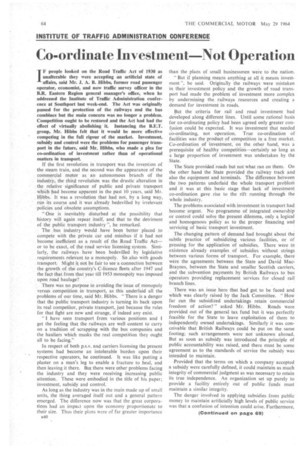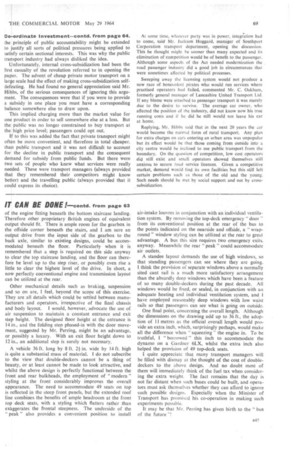Co-ordinate Investment Not Operation
Page 66

Page 71

If you've noticed an error in this article please click here to report it so we can fix it.
IF people looked on the Road Traffic Act of 1930 as unalterable they were accepting an artificial state of affairs, said Mr. A. A. B. Hibbs, former road passenger operator, economist, and now traffic survey officer in the B.R. Eastern Region general manager's office, when he addressed the Institute of Traffic Administration conference at Southport last week-end. The Act was originally passed for the protection of the railways and the bus combines but the main concern was no longer a problem. Competition ought to he restored and the Act had had the effect of virtually abolishing it. Instancing the B.E.T. group, Mr. Hibbs felt that it would be more effective competing in the full rigour of the market. Investment, subsidy and control were the problems for passenger transport in the future,' said Mr. Hibbs, who made a plea for co-ordination of investment rather than of operational matters in transport.
If the first revolution in transport was the invention of the steam train, and the second was the appearance of the commercial motor as an autonomous branch of the industry,the third revolution was the drastic alteration in the relative significance of public and private transport whieh tad become apparent in the past 10 years, said Mr. Hibbs, It was a revolution that had not, by a long way, run its course and it was already. bedevilled by irrelevant policies and obsolete assumptions.
"One is inevitably disturbed at the possibility that history will again repeat itself, and that to the detriment of the public transport industry ", he remarked.
The bus industry would have been better placed to compete with the private car and minibus if it had not become inefficient as a result of the RoadTraffic Act or to be exact, of the road service licensing system. Similarly, the railways have been bedevilled by legislative requirements relevant to a monopoly. So also with goods transport.Might it not be fair to see a connection between the growth of the country's c-licence fleets. after 1947 and the fact that from that year till t953 monopoly was imposed
upon road haulage? .
There was no purpose in avoiding the issue of monopoly versus competition in transport, as this underlaid all the problems of our time, said Mr. Hibbs. " There is a danger that the public transport industry is turning its back upon its real competitor, private transport, just because the rules for that fight are new and strange, if indeed any exist.
"I have seen transport from various positions and I get the feeling that the railways are well content to carry on a tradition of scrapping with the bus companies and the hauliers which masks the real competition they ought all to he facing."
In respect of both p.s.v, and carriers licensing the present systems had become an intolerable burden upon their respective operators, he continued. It was like putting a plaster on a man's leg to enable a fracture to heal, and then leaving it there. But there were other problems facing the industry and they were receiving increasing public attention. These were embodied in the title of his paper; investment, subsidy and control.
As long as the industry was in the main made up of small units, the thing averaged itself out and a general pattern emerged. The difference now was that the great corporations had an impact upon the economy proportionate to their size. Thus their plans were of far greater importance a40 ,. than the plans of small businessmen were to the nation.
" But if planning means anything at all it means investment ", he said. Originally the railways were mistaken in their investment policy and the growth of road transport had made the problem of investment more complex by undermining the railways resources and creating a demand for investment in roads.
But the criteria for rail and road investment had developed along different lines. Until some rational basis for co-ordinating policy had been agreed only greater contusion could be expected. It was investment that needed co-ordinating, not operation. True co-ordination of facilities was the product of competition in a free market. Co-ordination of investment, on the Other hand, was a prerequisite of healthy competition—certainly so long as a large proportion of investment was undertaken by the State. • The State provided roads but not what ran on them. On the other hand the State provided the railway track and also the equipment and terminals. The difference between the two patterns underlaid the whole transport problern and it was at this basic stage that lack of investment co-ordination gave rise to the rift running through the whole industry.
The problems associated with investment in transport had become urgent. No programme of integrated ownership or control could solve the present dilemma, only a logical and homogenous policy as to the proper financing and servicing of basic transport investment.
The changing pattern of demand had brought about the subtle practice of subsidizing various facilities, or of pressing for the application of subsidies. There were in existence already examples of subsidies without strings between various forms of transport. For example, there were the agreements between the State and David MacBraynes,. between the State and smaller Scottish carriers, and the subvention payments by British Railways to bus operators providing replacement services for closed rail branch lines.
There was an issue here that had got, to be faced and which was clearly raised by the Jack Committee. "How far can the subsidized undertakings retain commercial freedom of action?" asked Mr. Hibbs. Roads were provided out of the general tax fund but it was perfectly feasible for the State to leave exploitation of them to independently owned undertakings. Similarly it was conceivable that British Railways could be put on the same footing; such arrangements were not unknown abroad. But as soon as subsidy was introduced the principle of public accountability was raised, and there must be some agreement as to the standards of service the subsidy was intended to maintain.
Provided that the terms on which a company accepted a subsidy were carefully defined, it could maintain as much integrity of commercial judgrnent as was necessary to retain its true independence. An organization set up purely to provide a facility entirely out of public funds must maintain a similar integrity.
The danger involved in applying subsidies from public money to maintain artificially high levels of public service was that a confusion of intention could arise, Furthermore,
Co-ordinate Investment—contd. from page 64. the principle of public accountability might be extended to justify all sorts of political pressures being applied to satisfy certain sectional interests. This was why the public transport industry had always disliked the idea.
Unfortunately, internal cross-subsidization had been the first casualty of the revolution referred to in opening the paper. The advent of cheap private motor transport on a large scale had the effect of making cross-subsidization selfdefeating. He had found no general appreciation said Mr. Hibbs, of the serious consequences of ignoring this argument. The consequences were that if you were to provide a subsidy in one place you must have a corresponding balance somewhere else to draw upon.
This implied charging more than the market value for one product in order to sell somewhere else at a loss. But the public was no longer constrained to buy transport at the high price level; passengers could opt out.
If to this was added the fact that private transport might often be more convenient, and therefore in total cheaper, than public transport and it was not difficult to account for the decline in public transport and the consequent demand for subsidy from public funds. But there were two sets of people who knew what services were really needed, These were transport managers (always provided that they remembered their competitors might know better) and the travelling public (always provided that it could express its choice).
At some time, whatever party was in power, integration had to come, said Mr. Jackson Hogg,ard, manager of Southport Corporation transport department, opening the discussion. This he thought might he sooner than many expected and its elimination of-competition would be of benefit to the passenger. Although some aspects of the Act needed modernization the , road passenger industry did a good job in circumstances that were sometimes affected by political processes.
Sweeping away the licensing system would not produce a new race of benevolent pirates who would run services where practised operators had failed, commented Mr. C. Oakham, formerly general manager of Lancashire United Transport Ltd. If any blame were attached to passenger transport it was merely Ale to the desire to survive. The average car owner, who affected the position of the industry, did not know now his true running costs and if he did he still would not leave his car at home.
Replying, Mr. -Hibbs said that in the next 20 years the car would become the normal form of rural transport. Any plan for extra charges on cars entering an urban area was unpopular but its effect would be that those coming from outside into a city centre would be inclined to use public transport from the boundary. On the question of competition, low cost operators did still exist and small .operators showed themselves still anxious to secure toad service licences. Given a competitive market, demand would find its own facilities but this still left certain problems such as those of the old and the young. Such needs should be met by social support and not by crosssubsidization.




















































































































